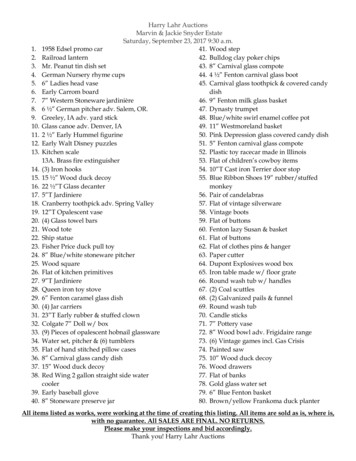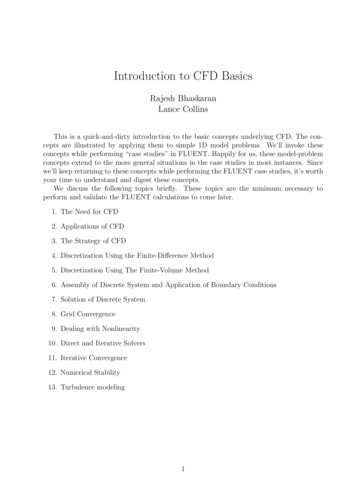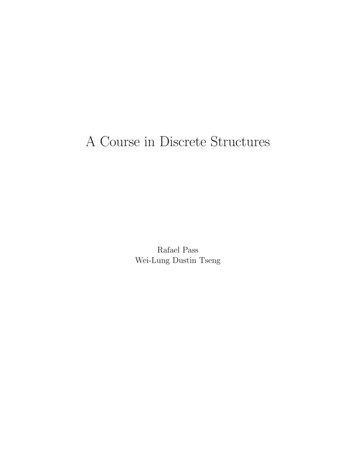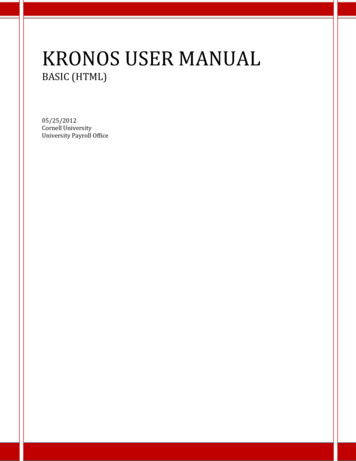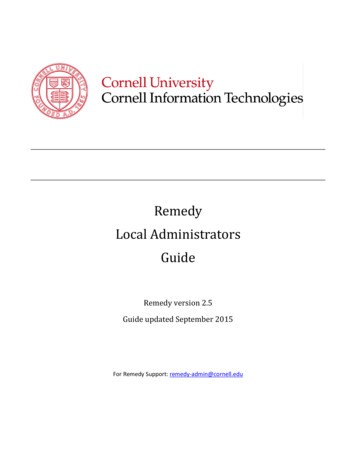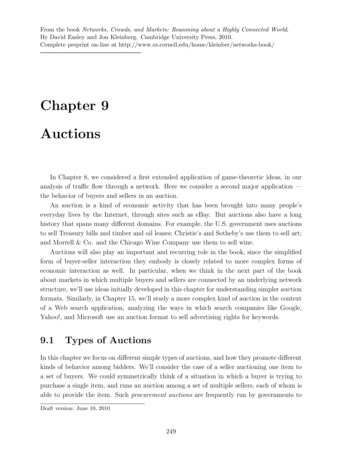
Transcription
From the book Networks, Crowds, and Markets: Reasoning about a Highly Connected World.By David Easley and Jon Kleinberg. Cambridge University Press, 2010.Complete preprint on-line at ook/Chapter 9AuctionsIn Chapter 8, we considered a first extended application of game-theoretic ideas, in ouranalysis of traffic flow through a network. Here we consider a second major application —the behavior of buyers and sellers in an auction.An auction is a kind of economic activity that has been brought into many people’severyday lives by the Internet, through sites such as eBay. But auctions also have a longhistory that spans many different domains. For example, the U.S. government uses auctionsto sell Treasury bills and timber and oil leases; Christie’s and Sotheby’s use them to sell art;and Morrell & Co. and the Chicago Wine Company use them to sell wine.Auctions will also play an important and recurring role in the book, since the simplifiedform of buyer-seller interaction they embody is closely related to more complex forms ofeconomic interaction as well. In particular, when we think in the next part of the bookabout markets in which multiple buyers and sellers are connected by an underlying networkstructure, we’ll use ideas initially developed in this chapter for understanding simpler auctionformats. Similarly, in Chapter 15, we’ll study a more complex kind of auction in the contextof a Web search application, analyzing the ways in which search companies like Google,Yahoo!, and Microsoft use an auction format to sell advertising rights for keywords.9.1Types of AuctionsIn this chapter we focus on different simple types of auctions, and how they promote differentkinds of behavior among bidders. We’ll consider the case of a seller auctioning one item toa set of buyers. We could symmetrically think of a situation in which a buyer is trying topurchase a single item, and runs an auction among a set of multiple sellers, each of whom isable to provide the item. Such procurement auctions are frequently run by governments toDraft version: June 10, 2010249
250CHAPTER 9. AUCTIONSpurchase goods. But here we’ll focus on the case in which the seller runs the auction.There are many different ways of defining auctions that are much more complex thanwhat we consider here. The subsequent chapters will generalize our analysis to the case inwhich there are multiple goods being sold, and the buyers assign different values to thesegoods. Other variations, which fall outside the scope of the book, include auctions in whichgoods are sold sequentially over time. These more complex variations can also be analyzedusing extensions of the ideas we’ll talk about here, and there is a large literature in economicsthat considers auctions at this broad level of generality [256, 292].The underlying assumption we make when modeling auctions is that each bidder has anintrinsic value for the item being auctioned; she is willing to purchase the item for a priceup to this value, but not for any higher price. We will also refer to this intrinsic value as thebidder’s true value for the item. There are four main types of auctions when a single item isbeing sold (and many variants of these types).1. Ascending-bid auctions, also called English auctions. These auctions are carried outinteractively in real time, with bidders present either physically or electronically. Theseller gradually raises the price, bidders drop out until finally only one bidder remains,and that bidder wins the object at this final price. Oral auctions in which biddersshout out prices, or submit them electronically, are forms of ascending-bid auctions.2. Descending-bid auctions, also called Dutch auctions. This is also an interactive auctionformat, in which the seller gradually lowers the price from some high initial value untilthe first moment when some bidder accepts and pays the current price. These auctionsare called Dutch auctions because flowers have long been sold in the Netherlands usingthis procedure.3. First-price sealed-bid auctions. In this kind of auction, bidders submit simultaneous“sealed bids” to the seller. The terminology comes from the original format for suchauctions, in which bids were written down and provided in sealed envelopes to theseller, who would then open them all together. The highest bidder wins the object andpays the value of her bid.4. Second-price sealed-bid auctions, also called Vickrey auctions. Bidders submit simultaneous sealed bids to the sellers; the highest bidder wins the object and pays thevalue of the second-highest bid. These auctions are called Vickrey auctions in honorof William Vickrey, who wrote the first game-theoretic analysis of auctions (includingthe second-price auction [400]). Vickery won the Nobel Memorial Prize in Economicsin 1996 for this body of work.
9.2. WHEN ARE AUCTIONS APPROPRIATE?9.2251When are Auctions Appropriate?Auctions are generally used by sellers in situations where they do not have a good estimateof the buyers’ true values for an item, and where buyers do not know each other’s values. Inthis case, as we will see, some of the main auction formats can be used to elicit bids frombuyers that reveal these values.Known Values. To motivate the setting in which buyers’ true values are unknown, let’sstart by considering the case in which the seller and buyers know each other’s values for anitem, and argue that an auction is unnecessary in this scenario. In particular, suppose thata seller is trying to sell an item that he values at x, and suppose that the maximum valueheld by a potential buyer of the item is some larger number y. In this case, we say there is asurplus of y x that can be generated by the sale of the item: it can go from someone whovalues it less (x) to someone who values it more (y).If the seller knows the true values that the potential buyers assign to the item, then hecan simply announce that the item is for sale at a fixed price just below y, and that he willnot accept any lower price. In this case, the buyer with value y will buy the item, and thefull value of the surplus will go to the seller. In other words, the seller has no need for anauction in this case: he gets as much as he could reasonably expect just by announcing theright price.Notice that there is an asymmetry in the formulation of this example: we gave the sellerthe ability to commit to the mechanism that was used for selling the object. This abilityof the seller to “tie his hands” by committing to a fixed price is in fact very valuable tohim: assuming the buyers believe this commitment, the item is sold for a price just belowy, and the seller makes all the surplus. In contrast, consider what would happen if we gavethe buyer with maximum value y the ability to commit to the mechanism. In this case,this buyer could announce that she is willing to purchase the item for a price just abovethe larger of x and the values held by all other buyers. With this announcement, the sellerwould still be willing to sell — since the price would be above x — but now at least someof the surplus would go to the buyer. As with the seller’s commitment, this commitment bythe buyer also requires knowledge of everyone else’s values.These examples show how commitment to a mechanism can shift the power in the transaction in favor of the seller or the buyer. One can also imagine more complex scenarios inwhich the seller and buyers know each other’s values, but neither has the power to unilaterally commit to a mechanism. In this case, one may see some kind of bargaining take placeover the price; we discuss the topic of bargaining further in Chapter 12. As we will discoverin the current chapter, the issue of commitment is also crucial in the context of auctions —specifically, it is important that a seller be able to reliably commit in advance to a givenauction format.
252CHAPTER 9. AUCTIONSUnknown Values. Thus far we’ve been discussing how sellers and buyers might interactwhen everyone knows each other’s true values for the item. Beginning in the next section,we’ll see how auctions come into play when the participants do not know each other’s values.For most of this chapter we will restrict our attention to the case in which the buyershave independent, private values for the item. That is, each buyer knows how much shevalues the item, she does not know how much others value it, and her value for it does notdepend on others’ values. For example, the buyers could be interested in consuming theitem, with their values reflecting how much they each would enjoy it.Later we will also consider the polar opposite of this setting — the case of commonvalues. Suppose that an item is being auctioned, and instead of consuming the item, eachbuyer plans to resell the item if she gets it. In this case (assuming the buyers will do acomparably good job of reselling it), the item has an unknown but common value regardlessof who acquires it: it is equal to how much revenue this future reselling of the item willgenerate. Buyers’ estimates of this revenue may differ if they have some private informationabout the common value, and so their valuations of the item may differ. In this setting, thevalue each buyer assigns to the object would be affected by knowledge of the other buyers’valuations, since the buyers could use this knowledge to further refine their estimates of thecommon value.9.3Relationships between Different Auction FormatsOur main goal will be to consider how bidders behave in different types of auctions. We beginin this section with some simple, informal observations that relate behavior in interactiveauctions (ascending-bid and descending-bid auctions, which play out in real time) withbehavior in sealed-bid auctions. These observations can be made mathematically rigorous,but for the discussion here we will stick to an informal description.Descending-Bid and First-Price Auctions. First, consider a descending-bid auction.Here, as the seller is lowering the price from its high initial starting point, no bidder saysanything until finally someone actually accepts the bid and pays the current price. Bidderstherefore learn nothing while the auction is running, other than the fact that no one hasyet accepted the current price. For each bidder i, there’s a first price bi at which she’ll bewilling to break the silence and accept the item at price bi . So with this view, the processis equivalent to a sealed-bid first-price auction: this price bi plays the role of bidder i’s bid;the item goes to the bidder with the highest bid value; and this bidder pays the value of herbid in exchange for the item.
9.3. RELATIONSHIPS BETWEEN DIFFERENT AUCTION FORMATS253Ascending-Bid and Second-Price Auctions. Now let’s think about an ascending-bidauction, in which bidders gradually drop out as the seller steadily raises the price. Thewinner of the auction is the last bidder remaining, and she pays the price at which thesecond-to-last bidder drops out.1Suppose that you’re a bidder in such an auction; let’s consider how long you should stayin the auction before dropping out. First, does it ever make sense to stay in the auction afterthe price reaches your true value? No: by staying in, you either lose and get nothing, or elseyou win and have to pay more than your value for the item. Second, does it ever make senseto drop out before the price reaches your true value for the item? Again, no: if you dropout early (before your true value is reached), then you get nothing, when by staying in youmight win the item at a price below your true value.So this informal argument indicates that you should stay in an ascending-bid auction upto the exact moment at which the price reaches your true value. If we think of each bidderi’s “drop-out price” as her bid bi , this says that people should use their true values as theirbids.Moreover, with this definition of bids, the rule for determining the outcome of an ascendingbid auction can be reformulated as follows. The person with the highest bid is the one whostays in the longest, thus winning the item, and she pays the price at which the second-tolast person dropped out — in other words, she pays the bid of this second-to-last person.Thus, the item goes to the highest bidder at a price equal to the second-highest bid. Thisis precisely the rule used in the sealed-bid second-price auction, with the difference beingthat the ascending-bid auction involves real-time interaction between the buyers and seller,while the sealed-bid version takes place purely through sealed bids that the seller opens andevaluates. But the close similarity in rules helps to motivate the initially counter-intuitivepricing rule for the second-price auction: it can be viewed as a simulation, using sealedbids, of an ascending-bid auction. Moreover, the fact that bidders want to remain in anascending-bid auction up to exactly the point at which their true value is reached providesthe intuition for what will be our main result in the next section: after formulating thesealed-bid second-price auction in terms of game theory, we will find that bidding one’s truevalue is a dominant strategy.1It’s conceptually simplest to think of three things happening simultaneously at the end of an ascendingbid auction: (i) the second-to-last bidder drops out; (ii) the last remaining bidder sees that she is alone andstops agreeing to any higher prices; and (iii) the seller awards the item to this last remaining bidder at thecurrent price. Of course, in practice we might well expect that there is some very small increment by whichthe bid is raised in each step, and that the last remaining bidder actually wins only after one more raisingof the bid by this tiny increment. But keeping track of this small increment makes for a more cumbersomeanalysis without changing the underlying ideas, and so we will assume that the auction ends at precisely themoment when the second-highest bidder drops out.
254CHAPTER 9. AUCTIONSComparing Auction Formats. In the next two sections we will consider the two mainformats for sealed-bid auctions in more detail. Before doing this, it’s worth making twopoints. First, the discussion in this section shows that when we analyze bidder behavior in sealed-bid auctions, we’re also learning about their interactive analogues — withthe descending-bid auction as the analogue of the sealed-bid first-price auction, and theascending-bid auction as the analogue of the sealed-bid second-price auction.Second, a purely superficial comparison of the first-price and second-price sealed-bidauctions might suggest that the seller would get more money for the item if he ran a firstprice auction: after all, he’ll get paid the highest bid rather than the second-highest bid. Itmay seem strange that in a second-price auction, the seller is intentionally underchargingthe bidders. But such reasoning ignores one of the main messages from our study of gametheory — that when you make up rules to govern people’s behavior, you have to assumethat they’ll adapt their behavior in light of the rules. Here, the point is that bidders in afirst-price auction will tend to bid lower than they do in a second-price auction, and in factthis lowering of bids will tend to offset what would otherwise look like a difference in thesize of the winning bid. This consideration will come up as a central issue at various pointslater in the chapter.9.4Second-Price AuctionsThe sealed-bid second-price auction is particularly interesting, and there are a number ofexamples of it in widespread use. The auction form used on eBay is essentially a second-priceauction. The pricing mechanism that search engines use to sell keyword-based advertising isa generalization of the second-price auction, as we will see in Chapter 15. One of the mostimportant results in auction theory is the fact we mentioned toward the end of the previoussection: with independent, private values, bidding your true value is a dominant strategy ina second price sealed-bid auction. That is, the best choice of bid is exactly what the objectis worth to you.Formulating the Second-Price Auction as a Game. To see why this is true, weset things up using the language of game theory, defining the auction in terms of players,strategies, and payoffs. The bidders will correspond to the players. Let vi be bidder i’s truevalue for the object. Bidder i’s strategy is an amount bi to bid as a function of her truevalue vi . In a second-price sealed-bid auction, the payoff to bidder i with value vi and bid biis defined as follows.If bi is not the winning bid, then the payoff to i is 0. If bi is the winning bid, andsome other bj is the second-place bid, then the payoff to i is vi bj .
9.4. SECOND-PRICE AUCTIONSAlternate bid bi'255Raised bid affects outcome only ifhighest other bid bj is in between.If so, i wins but pays more than value.Truthful bid bi viLowered bid affects outcome only ifhighest other bid bk is in between.Alternate bid bi''If so, i loses when it was possibleto win with non-negative payoffFigure 9.1: If bidder i deviates from a truthful bid in a second-price auction, the payoff isonly affected if the change in bid changes the win/loss outcome.To make this completely well-defined, we need to handle the possibility of ties: what dowe do if two people submit the same bid, and it’s tied for the largest? One way to handle thisis to assume that there is a fixed ordering on the bidders that is agreed on in advance, and ifa set of bidders ties for the numerically largest bid, then the winning bid is the one submittedby the bidder in this set that comes first in this order. Our formulation of the payoffs workswith this more refined definition of “winning bid” and “second-place bid.” (And note thatin the case of a tie, the winning bidder receives the item but pays the full value of her ownbid, for a payoff of zero, since in the event of a tie the first-place and second-place bids areequal.)There is one further point worth noting about our formulation of auctions in the languageof game theory. When we defined games in Chapter 6, we assumed that each player knew thepayoffs of all players in the game. Here this isn’t the case, since the bidders don’t know eachother’s values, and so strictly speaking we need to use a slight generalization of the notions
256CHAPTER 9. AUCTIONSfrom Chapter 6 to handle this lack of knowledge. For our analysis here, however, since weare focusing on dominant strategies in which a player has an optimal strategy regardless ofthe other players’ behavior, we will be able to disregard this subtlety.Truthful Bidding in Second-Price Auctions. The precise statement of our claim aboutsecond-price auctions is as follows.Claim: In a sealed-bid second-price auction, it is a dominant strategy for eachbidder i to choose a bid bi vi .To prove this claim, we need to show that if bidder i bids bi vi , then no deviation fromthis bid would improve her payoff, regardless of what strategy everyone else is using. Thereare two cases to consider: deviations in which i raises her bid, and deviations in which ilowers her bid. The key point in both cases is that the value of i’s bid only affects whetheri wins or loses, but never affects how much i pays in the event that she wins — the amountpaid is determined entirely by the other bids, and in particular by the largest among theother bids. Since all other bids remain the same when i changes her bid, a change to i’s bidonly affects her payoff if it changes her win/loss outcome. This argument is summarized inFigure 9.1.With this in mind, let’s consider the two cases. First, suppose that instead of biddingvi , bidder i chooses a bid b!i vi . This only affects bidder i’s payoff if i would lose with bidvi but would win with bid b!i . In order for this to happen, the highest other bid bj must bebetween bi and b!i . In this case, the payoff to i from deviating would be at most vi bj 0,and so this deviation to bid b!i does not improve i’s payoff.Next, suppose that instead of bidding vi , bidder i chooses a bid b!!i vi . This only affectsbidder i’s payoff if i would win with bid vi but would lose with bid b!!i . So before deviating,vi was the winning bid, and the second-place bid bk was between vi and b!!i . In this case, i’spayoff before deviating was vi bk 0, and after deviating it is 0 (since i loses), so againthis deviation does not improve i’s payoff.This completes the argument that truthful bidding is a dominant strategy in a sealedbid second-price auction. The heart of the argument is the fact noted at the outset: in asecond-price auction, your bid determines whether you win or lose, but not how much youpay in the event that you win. Therefore, you need to evaluate changes to your bid in lightof this. This also further highlights the parallels to the ascending-bid auction. There too,the analogue of your bid — i.e. the point up to which you’re willing to stay in the auction— determines whether you’ll stay in long enough to win; but the amount you pay in theevent that you win is determined by the point at which the second-place bidder drops out.The fact that truthfulness is a dominant strategy also makes second-price auctions conceptually very clean. Because truthful bidding is a dominant strategy, it is the best thingto do regardless of what the other bidders are doing. So in a second-price auction, it makes
9.5. FIRST-PRICE AUCTIONS AND OTHER FORMATS257sense to bid your true value even if other bidders are overbidding, underbidding, colluding,or behaving in other unpredictable ways. In other words, truthful bidding is a good idea evenif the competing bidders in the auction don’t know that they ought to be bidding truthfullyas well.We now turn to first-price auctions, where we’ll find that the situation is much morecomplex. In particular, each bidder now has to reason about the behavior of her competitorsin order to arrive at an optimal choice for her own bid.9.5First-Price Auctions and Other FormatsIn a sealed-bid first-price auction, the value of your bid not only affects whether you win butalso how much you pay. As a result, most of the reasoning from the previous section has tobe redone, and the conclusions are now different.To begin with, we can set up the first-price auction as a game in essentially the sameway that we did for second-price auctions. As before, bidders are players, and each bidder’sstrategy is an amount to bid as a function of her true value. The payoff to bidder i withvalue vi and bid bi is simply the following.If bi is not the winning bid, then the payoff to i is 0. If bi is the winning bid,then the payoff to i is vi bi .The first thing we notice is that bidding your true value is no longer a dominant strategy.By bidding your true value, you would get a payoff of 0 if you lose (as usual), and you wouldalso get a payoff of 0 if you win, since you’d pay exactly what it was worth to you.As a result, the optimal way to bid in a first-price auction is to “shade” your bid slightlydownward, so that if you win you will get a positive payoff. Determining how much to shadeyour bid involves balancing a trade-off between two opposing forces. If you bid too close toyour true value, then your payoff won’t be very large in the event that you win. But if youbid too far below your true value, so as to increase your payoff in the event of winning, thenyou reduce your chance of being the high bid and hence your chance of winning at all.Finding the optimal trade-off between these two factors is a complex problem that depends on knowledge of the other bidders and their distribution of possible values. Forexample, it is intuitively natural that your bid should be higher — i.e. shaded less, closerto your true value — in a first-price auction with many competing bidders than in a firstprice auction with only a few competing bidders (keeping other properties of the bidders thesame). This is simply because with a large pool of other bidders, the highest competing bidis likely to be larger, and hence you need to bid higher to get above this and be the highestbid. We will discuss how to determine the optimal bid for a first-price auction in Section 9.7.
258CHAPTER 9. AUCTIONSAll-pay auctions. There are other sealed-bid auction formats that arise in different settings. One that initially seems counter-intuitive in its formulation is the all-pay auction:each bidder submits a bid; the highest bidder receives the item; and all bidders pay theirbids, regardless of whether they win or lose. That is, the payoffs are now as follows.If bi is not the winning bid, then the payoff to i is bi . If bi is the winning bid,then the payoff to i is vi bi .Games with this type of payoff arise in a number of situations, usually where the notionof “bidding” is implicit. Political lobbying can be modeled in this way: each side mustspend money on lobbying, but only the successful side receives anything of value for thisexpenditure. While it is not true that the side spending more on lobbying always wins, thereis a clear analogy between the amount spent on lobbying and a bid, with all parties payingtheir bid regardless of whether they win or lose. One can picture similar considerationsarising in settings such as design competitions, where competing architectural firms spendmoney on preliminary designs to try to win a contract from a client. This money must bespent before the client makes a decision.The determination of an optimal bid in an all-pay auction shares a number of qualitativefeatures with the reasoning in a first-price auction: in general you want to bid below your truevalue, and you must balance the trade-off between bidding high (increasing your probabilityof winning) and bidding low (decreasing your expenditure if you lose and increasing yourpayoff if you win). In general, the fact that everyone must pay in this auction format meansthat bids will typically be shaded much lower than in a first-price auction. The frameworkwe develop for determining optimal bids in first-price auctions will also apply to all-payauctions, as we will see in Section 9.7.9.6Common Values and The Winner’s CurseThus far, we have assumed that bidders’ values for the item being auctioned are independent:each bidder knows her own value for the item, and is not concerned with how much it is worthto anyone else. This makes sense in a lot of situations, but it clearly doesn’t apply to a settingin which the bidders intend to resell the object. In this case, there is a common eventualvalue for the object — the amount it will generate on resale — but it is not necessarilyknown. Each bidder i may have some private information about the common value, leadingto an estimate vi of this value. Individual bidder estimates will typically be slightly wrong,and they will also typically not be independent of each other. One possible model for suchestimates is to suppose that the true value is v, and that each bidder i’s estimate vi is definedby vi v xi , where xi is a random number with a mean of 0, representing the error in i’sestimate.
9.6. COMMON VALUES AND THE WINNER’S CURSE259Auctions with common values introduce new sources of complexity. To see this, let’sstart by supposing that an item with a common value is sold using a second-price auction.Is it still a dominant strategy for bidder i to bid vi ? In fact, it’s not. To get a sense for whythis is, we can use the model with random errors v xi . Suppose there are many bidders,and that each bids her estimate of the true value. Then from the result of the auction, thewinning bidder not only receives the object, she also learns something about her estimateof the common value — that it was the highest of all the estimates. So in particular, herestimate is more likely to be an over-estimate of the common value than an under-estimate.Moreover, with many bidders, the second-place bid — which is what she paid — is also likelyto be an over-estimate. As a result she will likely lose money on the resale relative to whatshe paid.This is known as the winner’s curse, and it is a phenomenon that has a rich history inthe study of auctions. Richard Thaler’s review of this history [387] notes that the winner’scurse appears to have been first articulated by researchers in the petroleum industry [95].In this domain, firms bid on oil-drilling rights for tracts of land that have a common value,equal to the value of the oil contained in the tract. The winner’s curse has also been studiedin the context of competitive contract offers to baseball free agents [98] — with the unknowncommon value corresponding to the future performance of the baseball player being courted.2Rational bidders should take the winner’s curse into account in deciding on their bids: abidder should bid her best estimate of the value of the object conditional on both her privateestimate vi and on winning the object at her bid. That is, it must be the case that at anoptimal bid, it is better to win the object than not to win it. This means in a common-valueauction, bidders will shade their bids downward even when the second-price format is used;with the first-price format, bids will be reduced even further. Determining the optimal bidis fairly complex, and we will not pursue the details of it here. It is also worth noting thatin practice, the winner’s curse can lead to outright losses on the part of the winning bidder[387], since in a large pool of bidders, anyone who in fact makes an error and overbids ismore likely to be the winner of the auction.In these cases as well as others, one could argue that the model of common values is not entirely accurate.One oil company could in principle be more successful than another at extracting oil from a tract of land;and a baseball free agent may flourish if he joins one team but fail if he joins another. But common valuesare a reasonable approximation to both sett
to sell Treasury bills and timber and oil leases; Christie’s and Sotheby’s use them to sell art; and Morrell & Co. and the Chicago Wine Company use them to sell wine. Auctions will also play an important and recurring role in the book, since the simplified form of buyer-seller interactio
